![]()
![]()
![]()
Use LEFT and RIGHT arrow keys to navigate between flashcards;
Use UP and DOWN arrow keys to flip the card;
H to show hint;
A reads text to speech;
151 Cards in this Set
- Front
- Back
- 3rd side (hint)
|
Between the seventh and sixth century BCE, the people known as the Etruscans, probably related to the __________, gained control of northern and much of central Italy.
Phoenicians Greeks Vilanovans |
Vilanovans
|
|
|
|
The Roman Republic was established in the __________ century BCE.
seventh fifth sixth |
sixth
|
|
|
|
The typical Etruscan city was laid out in what kind of plan?
grid circular triangular |
grid
|
|
|
|
Etruscan beliefs about the afterlife may have been somewhat similar to those of the __________.
Christians Greeks Egyptian |
Egyptian
|
|
|
|
The period of Roman history between 96 CE and 180 CE is often called the period of the ___________ Emperors.
Tetrarch Five Good Severan |
Five Good
|
|
|
|
Both the Maison Carrée and the Pont du Gard at Nîmes seem to summarize Roman architecture:
technologically advanced but ? in design. |
conservative
|
|
|
|
The Pont du Gard is a splendid example of an ?,
a structure built all over the Roman world to carry water from a source to a city population. |
aqueduct
|
|
|
|
The wall painting from the House of Publius Fannius Synistor ? the space of a room visually with scenes of figures on a shallow "stage" or with a landscape or cityscape.
|
extended
|
|
|
|
For Romans, public baths were ?and educational centers, not simply places to wash.
|
recreational
|
|
|
|
The largest and most elaborate of the Imperial Forums was that of Trajan;
the emperor chose a Greek architect to design the forum. His name was ?. |
Apollodorus of Damascus
|
|
|
|
Porta Augusta, Perugia:
A. Severan B. Flavian C. Augustan D. Etruscan E. Republican |
D. Etruscan
|
|
|
|
Aulus Metellus:
A. Severan B. Flavian C. Augustan D. Etruscan E. Republican |
E. Republican
|
|
|
|
Portrait of Livia:
A. Severan B. Flavian C. Augustan D. Etruscan E. Republican |
C. Augustan
|
|
|
|
Young Woman with elaborate hair arrangement:
A. Severan B. Flavian C. Augustan D. Etruscan E. Republican |
B. Flavian
|
|
|
|
Portrait of Caracalla:
A. Severan B. Flavian C. Augustan D. Etruscan E. Republican |
A. Severan
|
|
|
|
The Colosseum has engaged columns on each story of the exterior;
these are placed in a logical succession from sturdy Tuscan to lighter Ionic to ? pilasters on the fourth story. Doric Composite Corinthian |
Composite
|
The lowest story is of the Doric order, the second is Ionic, the third Corinthian, and the fourth Composite.
|
|
|
Far from being somber, Etruscan sarcophagi often depict scenes of ?.
the circus objects of household use a domestic touch |
a domestic touch
|
|
|
|
Greek buildings reveal their building material.
In contrast, Roman buildings often show what instead of the building material? an applied surface raw cast concrete painted plaster |
an applied surface
|
|
|
|
The Augustus of Primaporta shows a typical Roman imperial form of idealism specifically ground in ?.
absolute adherence to the details of real life strict adherence to Greek idealism the appearance of the everyday world |
the appearance of the everyday world
|
|
|
|
In Rome, related individuals or members of social clubs and other organizations established private group cemeteries.
When a group's members had used up the ground-level space in their cemetery, they tunneled underground to create a hypogeum, or ?. mausoleum catacomb sarcophagus |
catacomb
|
|
|
|
Apollo from Veii:
A. marble B. terra-cotta C. wall painting D. carved onyx E. bronze |
B. terra-cotta
|
|
|
|
Musicians and Dancers from Tomb of the Lionesses, Tarquinia:
A. marble B. terra-cotta C. wall painting D. carved onyx E. bronze |
C. wall painting
|
|
|
|
Aulus Metellus:
A. marble B. terra-cotta C. wall painting D. carved onyx E. bronze |
E. bronze
|
|
|
|
Ara Pacis:
A. marble B. terra-cotta C. wall painting D. carved onyx E. bronze |
A. marble
|
|
|
|
Gemma Augustea:
A. marble B. terra-cotta C. wall painting D. carved onyx E. bronze |
D. carved onyx
|
|
|

Label parts of an arch and an arcade.
spandrel springing voussoirs centering keystone |
Correct order:
spandrel B. springing C. voussoirs D. centering E. keystone A. |
|
|

Label the parts of the Tuscan order.
shaft frieze column cornice capital plinth dado entablature pedestal base architrave |
Correct order:
shaft H. frieze E. column B. cornice D. capital G. plinth K. dado J. entablature C. pedestal A. base I. architrave F. |
|
|

Label three types of Roman wall construction.
opus incertum opus testaceum opus reticulatum |
opus incertum A.
opus testaceum C. opus reticulatum B. |
|
|
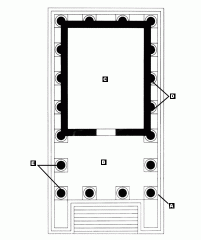
Label the parts of the plan of the temple perhaps dedicated to Portunus, Rome.
cella engaged columns porch freestanding columns podium |
cella C.
engaged columns D. porch B. freestanding columns E. podium A. |
|
|
|
Much of the decoration in Etruscan tombs was made from __________.
jewels stucco carved stone |
stucco
|
While the tombs were often hewn from stone, the decoration was applied to the stone walls using another material.
|
|
|
Late Roman portraits (late third and fourth century) often have deep areas that catch shadow; these areas were often achieved by use of ______________.
paint to create the illusion of shadow. chisel and drill to deepen shadows. wax additions to the finished stone sculpture. |
project from the architectural framework into the viewer's space.
|
|
|
|
Late Roman portraits (late third and fourth century) often have deep areas that catch shadow; these areas were often achieved by use of ______________.
paint to create the illusion of shadow. chisel and drill to deepen shadows. wax additions to the finished stone sculpture. |
chisel and drill to deepen shadows.
|
|
|
|
The Family of Vunnerius Keramus is made of what material?
encaustic painting engraved gemstone engraved and painted gold leaf between glass |
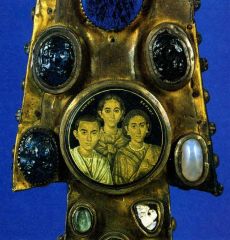
engraved and painted gold leaf between glass
|
Portrait of the family of Vunnerius Keramus. ca. AD 250.
The portrait was engraved and painted on sheets of gold leaf, then cut out and sealed between two layers of glass (later inserted as the central jewel in a decorated 7 cent. cross by its Christian owner). Diameter 2.375” (6 cm). Museo Civico dell’Eta Cristiana, Brescia. |
|
|
Etruscan artists excelled at making monumental sculpture of what material?
sandstone glass terra-cotta |
terra-cotta
|
|
|
|
The important remains of a house-synagogue, preserved because it was buried by citizens as part of their defense of the southwest rampart of their city in resistance to attack by Persian forces in 256 CE, are found in what site?
Jerusalem Antioch Dura-Europos |
Dura-Europos
|
Dura-Europos was a Hellenistic, Parthian, and Roman border city built on an escarpment 90 m above the right bank of the Euphrates river.
It is located near the village of Salhiyé, in today's Syria. |
|
|
Constantine the Great launched a vast building program that included Christian churches when he consolidated imperial power and united the West and East around _________.
384 324 524 |
324
|
|
|
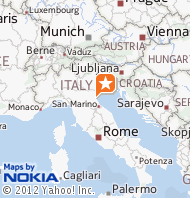
Much of our knowledge of Italian art of the turbulent period from the time of Honorius through control by Arian Ostrogoths to the victory of the Byzantine Empire comes from the well-preserved monuments of what city?
Ravenna Milan Rome |
Ravenna, Italy
|
|
|
|
Roger II held court in what city?
Kiev Skopje Palermo |
Palermo
|
|
|
|
The Emperor Leo III is best remembered in art history for what activity?
the launch of iconoclasm the final reversal of the policy of iconoclasm the building of Hagia Sophia that stands today in Istanbul |
the launch of iconoclasm
|
Iconoclasm is the deliberate destruction of religious icons and other symbols or monuments, usually with religious or political motives.
|
|
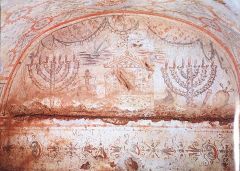
Villa Torlonia catacomb with an Ark of the Covenant wall painting:
Early Christian Middle Byzantine Late Byzantine Jewish Early Byzantine |
D. Jewish
|
|
|
|
Statues of Jonah Swallowed and Jonah Cast Up:
Early Christian Middle Byzantine Late Byzantine Jewish Early Byzantine |
A. Early Christian
|
|
|
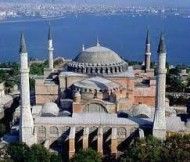
Hagia Sophia:
Early Christian Middle Byzantine Late Byzantine Jewish Early Byzantine |
E. Early Byzantine
|
|
|

Katholikon, Monastery of Hosios Loukas:
Early Christian Middle Byzantine Late Byzantine Jewish Early Byzantine |
B. Middle Byzantine
|
|
|
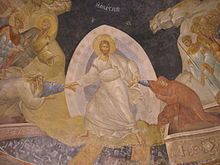
Anastasis, painting in the Church of the Monastery of Christ in Chora:
Early Christian Middle Byzantine Late Byzantine Jewish Early Byzantine |
C. Late Byzantine
|
|
|
|
The ambulatory of the Church of Santa Costanza is done in a construction technique called:
|
barrel-vaulting.
|
|
|
|
The image in the center of the central dome of the Church of the Dormition in Daphni, Greece evokes the promise of judgment; the image is of a type called Christ:
|
Pantokrator.
|
|
|
|
In the first half of the twelfth century, under Roger II, ? became one of the richest and most enlightened kingdoms in Europe.
|
Sicily
|
|
|
|
Among the important personages shown in the presentation mosaics at San Vitale, two probably did not ever visit the church.
They are Justinian and: |
Theodora.
|
|
|
|
Constantinople lies at the intersection of Europe and:
|
Asia.
|
|
|
|
The famous icon called The Old Testament Trinity was painted in the 15th century by whom?
Andrey Rublyov Anthemius of Tralles a monk named Rabbula |
Andrey Rublyov
|
|
|
|
The elaborately-carved object done for Junius Bassus was what?
a book cover an ivory diptych a sarcophagus |
a sarcophagus
|
Sarcophagus = name given by the Greeks to a special marble found in Asia Minor, near the territory of ancient Troy, and used in caskets.
|
|
|
What centralized building in Rome was built for and is named after the daughter of Constantine the Great?
Mausoleum of Galla Placidia Church of Santa Costanza Church of Saint Apollinaris |
Church of Santa Costanza
|
|
|
|
Theodore Metochites was responsible for funding the expansion of what important late Byzantine church?
Old St. Peter's San Vitale Church of the Monastery of Christ in Chora |
Church of the Monastery of Christ in Chora
|
|
|
|
Most early Christian churches have been rebuilt, some many times, but the Church of ? in Rome, constructed by Bishop Peter of Illyria between 422 and 432, appears much as it did in the fifth century.
Santa Sabina Old St. Peter's Cathedral of Saint Basil the Blessed |
Santa Sabina
|
|
|
|
Similar to basilica-plan churches, but possess a clearly defined transept that makes the plan take on the shape of a cross:
|
pilgrimage churches.
|
|
|
|
The continuous passage of pilgrimage churches that runs from the entrance to the choir allows pilgrims to visit the relics in the many small chapels without:
|
disturbing other services in the nave of the church.
|
|
|
|
The main doorway (portal) of Romanesque churches is often decorated with:
|
relief sculpture.
|
|
|
|
The trumeau (central post between double doors) of the Romanesque church may be carved with:
|
animals or figures.
|
|
|
|
The tympanium (rounded space just above the doors) of the Romanesque church most often contains:
|
an image of Christ as he will appear at the end.
|
Last Judgement or Second Coming of Christ
|
|
|
One of the few signed works from the middle ages, The Last Judgement, was probably created by Gislebertus.
Gislebertus's style is characterized by: |
sharply angular figures, parallel lines used to describe drapery, and a very imaginative treatment of the theme.
|
|
|
|
Gothic elements include:
|
pointed arch, ribbed vaulting, and extensive use of stained glass in windows.
|
|
|
|
The pointed arch accomplished two things:
|
1. a taller structure with the weight of the building pushing more directly downward
2. able to create more flexible spaces because a pointed arch can be opened wider or made narrower while still maintaining the same height. |
The height of a rounded arch is determined by the circle that makes the arch.
|
|
|
Originator of Gothic style:
|
Abbot Suger of Saint Dennis.
|
He was particularly interested in in the ideas of a first century Christian writer who described God as light.
|
|
|
Abbot Suger believed that:
|
1. light was a metaphor for God
2. the colored light from the stained glass windows was a way to unite the soul of the believer with God. |
|
|
|
Gothic sway:
|
1. resembles contrappasto
2. the movement is more S-shaped 3. one hip is thrust outward |
Some of the figures stand on short bases in a pose that sways gently.
|
|
|
During the sixteenth century, Counter-Reformation critics
wanted religious art that would clearly convey acceptable doctrine to the faithful. They were tired of: |
religious art that showed how talented the artist was at the expense of the message the painting contained
|
|
|
|
During the sixteenth century, Counter-Reformation critics were not the only ones calling for reform.
Other critics called for reform from: |
a more purely artistic point of view,
no matter what the piece’s subject matter. They felt that artists had stopped looking at nature and had moved too far from the perfection that the High Renaissance masters achieved. |
|
|
|
Some of the most important patrons of seventeenth century Italy art were:
|
cardinals.
|
|
|
|
During the Renaissance, the status of artists increased so that they were no longer thought of as mere workmen, but rather as:
|
people who were inspired in their work and who could
rise to the level of genius. |
|
|
|
One of the most important academies in the late sixteenth century was the:
|
Carracci academy in Bologna.
|
It began as an informal group of artists who felt that
mannerism had become sterile, unemotional, and too far removed from nature. |
|
|
The founders of the Carracci Academy in Bologna were:
|
Ludovico Carracci and his two slightly younger cousins, Agostino and Annibale.
|
By 1590, the academy had become more of a teaching institution
where students learned to draw from nature and heard lectures on literature, science, and art theory. |
|
|
Caravaggio (born Michelangelo Merisi) painted directly on:
|
canvas without evidence of underdrawing (this is called the alla prima technique)
He was often accused of not knowing how to draw. |
His religious paintings are powerful and captivating and allow the viewer to identify emotionally with the characters in the painting.
But Caravaggio was not a religious man; he was more the renegade, associating with prostitutes and thieves as often as he associated with churchmen and aristocrats |
|
|
Caravaggio’s method of making figures emerge from deep shadow is called ?,
and when these paintings are viewed in their dark chapels, the figures seem to literally: |
tenebrism
pop out of the walls. |
|
|
|
During the Baroque period,
women were not accepted as apprentices or as students in academies. ? is one of the few female artists from this period about whom we have information. |
Gentileschi
|
She was the daughter of a painter, from whom she learned her profession.
|
|
|
Gianlorenzo Bernini was one of the most prolific artists of the seventeenth century.
Like the Renaissance men of the preceding century, Bernini worked in all the media: |
architecture, sculpture, and painting.
|
More importantly (and typical of a baroque artist),
he brought the media together, treating his architecture as sculpture and bringing the painterly qualities of color and light into both architecture and sculpture. |
|
|
Bernini was always a dramatic artist—he captured facial expressions and theatrical gestures in even
his most simple portrait busts. Bernini’s early sculpture, ?, was done for a cardinal. |
David
|
Not long after the David was
carved, Bernini received his first commission at St. Peter’s. |
|
|
The pope in the early seventeenth century was Urban VIII of the Barberini family and was one of Bernini’s
patrons, so it was only natural that Bernini was given the job of: |
creating a gigantic
canopy over the high altar in 1624. |
The Baldacchino is as much a work of architecture as
sculpture: it is about one hundred feet tall, about the size of an eight-story building. |
|
|
? was named chief architect of St. Peter’s in 1627.
|
Bernini
|
Later, Bernini took on projects for other patrons in
Rome, including the Cornaro Chapel, with its sculpture the Saint Teresa of Ávila in Ecstasy. |
|
|
The most important Flemish baroque painter, ?,
went to Italy early in his career. |
Peter Paul Rubens
|
There were many
other painters working in Flanders in the seventeenth century, but Rubens so dominated the field, and so many artists were in his employ, that we can rightly consider Rubens to be the representative of Flemish baroque painting. |
|
|
? is similar to engraving in that lines are cut into a copper plate;
however, unlike engraving, the plate is first prepared with a coat of varnish. The artist scratches through this varnish to expose the copper plate. The plate, still coated in varnish, is immersed in acid that cuts the lines that have been exposed. Finally, the varnish is removed, and the plate is inked and printed in the same manner as an engraving. |
Etching
|
|
|
|
Frans Hals was a master of:
|
portraiture.
|
He developed a loose manner of painting in which brushstrokes seemed to be put down quickly,
without hesitancy or effort. He often captured people laughing or turning in their seats—as if in another moment, the view would be lost. |
|
|
The great master of the golden age of Dutch painting is:
|
Rembrandt van Rijn.
|
As a man
of remarkable talent and energy, but with a tendency to make rather bad business deals, Rembrandt’s life is as interesting as his paintings. |
|
|
? was a man of remarkable talent and energy,
but with a tendency to make rather bad business deals, |
Rembrandt van Rijn
|
Rembrandt’s life is as interesting as his paintings.
Indeed, his paintings often document his life because he made self-portraits throughout it. |
|
|
Rembrandt's most
famous group portrait is known as: |
The Night Watch.
|
The portrait shows the civic guard
company of Captain Frans Banning Cocq as if it were being called to arms. |
|
|
Rembrandt’s late works are among the most moving works in the history of art.
His brushwork became even rougher so that: |
the forms almost dissolve.
|
Action is reduced, and a sense of drama is achieved through psychological interaction rather than exaggerated gestures.
An example is the Return of the Prodigal Son. |
|
|
Jan Vermeer is best known for his:
|
genre painting.
|
In his hands, this type of painting took on an exquisite balance and serenity
unlike the crowded, boisterous genre scenes of his contemporaries. |
|
|
Vermeer’s mature paintings are generally:
|
small works,
focusing on one or two figures in a domestic setting, such as Woman Holding a Balance. |
|
|
|
The plan of Versailles, which was designed by André Le Nôtre, is based on:
|
avenues (they might be long pools of water or wide paths)
that radiate from important monuments in the park. |
The main axes converge on the king’s bedroom in the palace.
Order is further given to the landscape by the tightly composed, formal gardens close to the palace. The gardens gradually become less controlled, more natural areas in the farther reaches of the park. |
|
|
A type of painting that shows figures engaged in pleasant activities in a landscape setting:
|
fête galante.
|
|
|
|
A type of painting that shows figures engaged in pleasant activities in a landscape setting:
|
fête galante.
|
|
|
|
As royal power waned, royal patronage became less important, and ____ provided artists with most of their patronage.
|
wealthy aristocrats
|
Rococo period
|
|
|
The influential center of Europe during the Rococo period was:
|
Paris.
|
|
|
|
The Rococo developed in the early part of the 18th century in ____ as a reaction against the grandeur, symmetry, and strict regulations of the ____, especially that of the:
|
Paris, France
Baroque Palace of Versailles. |
|
|
|
____ art and architecture was ornate and made strong usage of creamy, pastel-like colours, asymmetrical designs, curves and gold.
|
Rococo
|
Unlike the more politically focused Baroque, the Rococo had more playful and often witty artistic themes.
The Rococo additionally played an important role in theatre. In the book The Rococo, it is written that there was no other culture which "has produced a wittier, more elegant, and teasing dialogue full of elusive and camouflaging language and gestures, refined feelings and subtle criticism" than Rococo theatre, especially that of France. |
|
|
Towards the end of the 18th century, Rococo started to fall out of fashion, and it was largely supplanted by the ____ style.
|
Neoclassic
|
|
|
|
The word Rococo is seen as a combination of the French rocaille, meaning ____, and coquilles, meaning ____, due to reliance on these objects as motifs of decoration.
|
stone
shell |
|
|
|
When the term "Rococo" was first used in English in about 1836, it was a colloquialism meaning:
|
"old-fashioned".
|
|
|
|
The Rococo style received harsh criticism, and was seen by some to be ____ and of poor taste,
especially when compared to neoclassicism; despite this, it has been praised for its ____ qualities, and since the mid-19th century, the term has been accepted by art historians. |
superficial
aesthetic |
aesthetic = A set of principles underlying and guiding the work of a particular artist or artistic movement.
|
|
|
Rococo origins lie in the late Baroque architectural work of:
|
Borromini (1599–1667) mostly in Rome and
Guarini (1624–83) mostly in Northern Italy but also in Vienna, Prague, Lisbon, and Paris. |
Italian architects of the late Baroque/early Rococo were wooed to Catholic (Southern) Germany, Bohemia , and Austria by local princes, bishops and prince-bishops.
|
|
|
These painters used delicate colors and curving forms, decorating their canvases with cherubs and myths of love.
|
Rococo period
|
|
|
|
_____ landscapes were pastoral and often depicted the leisurely outings of aristocratic couples.
|
Rococo
|
|
|
|
____ is generally considered the first great Rococo painter.
|
Jean-Antoine Watteau
(1684–1721) |
During the Rococo era Portraiture was an important component of painting in all countries,
but especially in Great Britain, where the leaders were William Hogarth (1697–1764), in a blunt realist style, and Francis Hayman (1708–1776), Angelica Kauffman who was Swiss, (1741–1807), Thomas Gainsborough and Joshua Reynolds (1723–1792), in more flattering styles influenced by Antony Van Dyck (1599–1641). |
|
|
____ is a French term referring to some of the celebrated pursuits of the idle, rich aristocrats in the 18th century—from 1715 until the 1770s.
|
Fête galante
|
The term translates from French literally as "gallant party".
|
|
|
____ is credited with developing a new category of painting, fête galante.
|
Jean-Antoine Watteau
|
These are paintings of modest size that show well-dressed people enjoying each other's company in an outdoor setting.
|
|
|
____ is best known for scenes of naked nymphs and cupids cavorting together.
|
Francois Boucher
|
|
|
|
One of the best-known English portraitists during the Rococo art period was:
|
Thomas Gainsborough.
|
|
|
|
Both the fete galante and the history painting depict people in a narrative scene,
but the fete galante is: History paintings are: |
smaller and more softly painted,
with a more playful or wistful tone. grand in scale and moral tone. |
|
|
|
Contrast baroque architecture, as seen in Versailles, with the rococo style of architecture, as seen in the Salon de la Princess.
What is a major difference between the two? |
Versailles had massive classical pilasters, but the Salon de la Princess has no such strong vertical accents.
|
|
|
|
Jean-Antoine Watteau's work Pilgrimage to Cythera and Jean-Honoré Fragonard's work The Progress of Love are similar to one another in what elements?
|
They have similar color schemes with pastels, corals, turquoises, and golds, and the figures in the paintings are similarly light and delicate.
|
|
|
|
What is a similarity between Jean-Baptiste-Siméon Chardin's women and Fragonard's women?
What is a difference? |
Both painters painted women with delicate heads, hands, and feet.
However, Fragonard's women tend to be flirtatious, and Chardin's women tend to be involved in domestic tasks. |
|
|
|
When the rococo style came to England, William Hogarth used it in a particular way.
Compare Marriage à la Mode with The Pilgrimage to Cythera. What is a major difference between the young couples in each painting? |
In Marriage, the young couple turns away from one another;
the flirtatiousness and longing of Pilgrimage has been replaced with boredom and the legal wranglings of an aristocratic marriage. |
|
|
|
Hogarth in particular was interested in what aspect of the rococo style?
|
He was interested in satirizing it for the lack of morality in British aristocratic society.
|
|
|
|
Thomas Gainsborough used which aspect(s) of rococo in his paintings?
|
He was primarily interested in the brushstrokes and the color palette.
|
|
|
|
Compared with Watteau and Chardin, Fragonard's paintings were much more:
|
overtly erotic.
|
|
|
|
In architecture, the practice of using styles of the past for new buildings;
sometimes, particular styles are associated with certain building types, such as Gothic style for religious buildings: |
historicism.
|
|
|
|
A sense of terror or awe in the presence of great power, especially natural forces:
|
sublime.
|
|
|
|
Classicism was most often seen in:
|
academic history painting.
|
|
|
|
In this period, people were interested in the "spirit" of classicism:
|
neo-classicism.
|
|
|
|
The remarkable excavations of Herculanean and Pompeii lay behind the new enthusiasm for:
|
classical art.
|
These cities contained not just the ruins of great temples like the ones standing in Rome today,
but also well-preserved houses with all of their decorative items and paintings. |
|
|
Because neoclassicism recalled the greatest empire the western world had known,
____ used it to help establish his authority in the first decade of the nineteenth century. |
Napolean
|
|
|
|
Romanticism, like neoclassicism, began as a reaction to the frivolity and insincerity of the rococo style.
But unlike neoclassicism, romanticism was: |
wild, passionate, imaginative, and strange.
|
It celebrated freedom and individuality, but not loyalty to a higher authority.
|
|
|
More often than passionate love, the great romantic painters expressed:
|
outrage at political events, awe in the face of uncontrollable natural forces, or terror when confronting nightmares or insanity.
|
Many works were inspired by literature.
|
|
|
Who painted "Oath of the Horatii", which shows some of the ideals of neoclassicism?
|
Jacque-Louis David
|
neo-classical style
Linear perspective style in which forms are define by sharp edges; brushstrokes are NOT visible and almost looks like statues; carefully balanced and austere; |
|
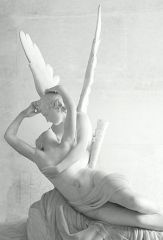
Of which style is "Cupid and Psyche", the sculpture by Canova, an example of?
|
Neoclassicism
|
Antonio Canova's statue Psyche Revived by Cupid's Kiss, first commissioned in 1787, exemplifies the Neoclassical devotion to love and emotion. It represents the god Cupid in the height of love and tenderness, immediately after awakening the lifeless Psyche with a kiss, a scene excerpted from Lucius Apuleius' The Golden Ass. A masterpiece of its period, it appeals to the senses of sight and touch, yet simultaneously alludes to the Romantic interest in emotion co-existing with Neoclassicism.
|
|
|
Which of the following choices would the Royal Academy in London have appreciated more?
|
?
|
The Royal Academy of Arts was founded through a personal act of King George III on 10 December 1768 with a mission to promote the arts of design in Britain through education and exhibition.
The motive in founding the Academy was twofold: to raise the professional status of the artist by establishing a sound system of training and expert judgment in the arts and to arrange the exhibition of contemporary works of art attaining an appropriate standard of excellence. Behind this concept was the desire to foster a national school of art and to encourage appreciation and interest in the public based on recognised canons of good taste. |
|
|
Sir Joseph Reynolds and John Singleton Copley both painted portraits,
but they had different goals when painting. How did Reynolds paint a picture? How did Copley? |
?
|
|
|
|
Neoclassical buildings in the eighteenth century tended to draw on the designs by which architect from what time period?
|
?
|
|
|
|
What were the two different styles Francisco Goya Y Lucientes worked in?
|
?
|
|
|
|
Theodore Gericault, in the "Raft of the Medussa", is unabashedly romantic in which element?
|
?
|
|
|
|
Why were Indian architectural forms chosen for the Royal Pavilion in Brighton?
What trend was being demonstrated? |
?
|
|
|
|
Who painted the Arena Chapel?
|
Giotto
|
|
|
|
Buon fresco uses:
|
paint made of pigment suspended in water and painted on wet plaster.
|
|
|
|
How does the Gothic style of sculpture differ from the Romanesque style?
|
Roman sculpture is often interlaced;
Gothic is angular, but more realistic. |
|
|
|
A common compositional form in the early Italian Renaissance form was:
|
a triangle.
|
|
|
|
Brunelleschi solved the problem of putting a dome on Florence Cathedral by:
|
constructing a huge timber frame for the dome, which stood on the floor of the cathedral while it was being built.
|
|
|
|
The Italian Renaissance started in which city?
|
?
|
|
|
|
Lorenzo Ghiberti:
|
won the competition for the Florence Baptistery doors.
|
Lorenzo Ghiberti (1378 – 1 December 1455), born Lorenzo di Bartolo, was an Italian artist of the early Renaissance best known as the creator of the bronze doors of the Baptistry of Florence Cathedral, named by Michelangelo the "Gates of Paradise".
|
|
|
The birth of Venus:
|
can be interpreted as a Neoplatonic allegory.
|
The Birth of Venus) is a 1486 painting by Sandro Botticelli.
It depicts the goddess Venus, having emerged from the sea as a fully grown woman, arriving at the sea-shore (which is related to the Venus Anadyomene motif). |
|
|
The Limbourg brothers are best known for their:
|
manuscript illustrations showing activities in each month of the year.
|
The Limbourg brothers (Herman, Paul, and Johan; fl. 1385 – 1416),
were famous Dutch miniature painters from the city of Nijmegen. They were active in the early 15th century in France and Burgundy, working in the style known as International Gothic. They created what is certainly the best known late medieval illuminated manuscript, the Très Riches Heures du Duc de Berry. The Très Riches Heures du Duc de Berry, or Très Riches Heures, is possibly the best example of French Gothic manuscript illumination surviving to the present day. |
|
|
The Merode Altarpiece:
|
shows objects like candles and mousetraps that have symbolic meanings.
|
The Mérode Altarpiece is a triptych by the Early Netherlandish painter Robert Campin,
although believed by some to be by a follower, probably copying an original by Campin. |
|
|
Which of the following are true of Leonardo's Last Supper?
|
1. Light from a window is used as a halo around Christ,
2. The composition is given variety by putting the apostles in four distinct groups, 3. Judas can be identified by the look of shock on his face. |
|
|
|
A print made by cutting lines into copper plate with a burin is called:
|
an engraving.
|
Engraving is the practice of incising a design on to a hard, usually flat surface, by cutting grooves into it.
The result may be a decorated object in itself, as when silver, gold, steel, or glass are engraved, or may provide an intaglio printing plate, of copper or another metal, for printing images on paper as prints or illustrations; these images are also called engravings. Engravers use a hardened steel tool called a burin, or graver to cut the design into the surface, most traditionally a copper plate |
|
|
When Michelangelo first started carving the David, where did he think it was going to be placed?
|
Along the roofline of the Florence Cathedral.
|
Originally commissioned as one of a series of statues of prophets to be positioned along the roofline of the east end of Florence Cathedral, the statue was instead placed in a public square, outside the Palazzo della Signoria, the seat of civic government in Florence, where it was unveiled on 8 September 1504.
Because of the nature of the hero that it represented, it soon came to symbolize the defence of civil liberties embodied in the Florentine Republic, an independent city-state threatened on all sides by more powerful rival states and by the hegemony of the Medici family. |
|
|
Raphael's Madonna paintings typically:
|
omit extraneous details, like landscapes in the background.
|
|
|
|
Titian's paintings are most often done:
|
in oil paint on canvas.
|
The majority of Titian’s work encompasses his oil paintings which feature figures and scenes from religion and myth with attention to detail, realism, and idealistic beauty.
He is also well-known for teaching fellow painters Tintoretto and Veronese. |
|
|
Which of the following artists were considered Mannerist?
|
Cellini, Pontormo, and Veronese
|
El Greco was NOT.
|
|
|
The Saint Teresa of Avila in Ecstasy:
|
is presented as if it were being enacted on a stage.
|
The Ecstasy of Saint Teresa is the central sculptural group in white marble set in an elevated aedicule in the Cornaro Chapel, Santa Maria della Vittoria, Rome.
It was designed and completed by Gian Lorenzo Bernini, the leading sculptor of his day, who also designed the setting of the Chapel in marble, stucco and paint. It is generally considered to be one of the sculptural masterpieces of the High Roman Baroque. It pictures Teresa of Ávila. |
|
|
The most important painter in the seventeenth century was:
|
the Italian painter, Caravaggio.
|
Though many artists cemented a place for themselves during the movement,
the most renowned were Michelangelo Merisi da Caravaggio, Peter Paul Rubens and Rembrandt for painting, and Bernini for sculptures. |
|
|
An artist who was called before the Inquisition to defend his work is:
|
Veronese.
|
Veronese had been commissioned to paint a depiction of the Last Supper for a convent in the city of Venice in 1573
The liberties that the artist took in interpreting an occasion fundamental to Christian faith triggered the displeasure of the city's Holy Tribunal of the Inquisition. Charged with the task of maintaining the orthodoxy of the Church, the Tribunal summoned Veronese to appear before it on July 18 in order to explain his actions and to answer the charge of heresy. The opening questions centered on the artist's placing of a dog at the Last Supper instead of the usual depiction of Mary Magdalene. At the conclusion of his interrogation, the Tribunal ordered the artist to change the elements of his painting that it found offensive. |
|
|
Judith Leyster's self-portrait:
|
displays an exuberant style, similar to Frans Hals'.
|
Judith Jans Leyster (July 28, 1609 – February 10, 1660) was a Dutch Golden Age painter.
She was one of three significant women artists in Dutch Golden Age painting; the other two, Rachel Ruysch and Maria van Oosterwijk, were specialized painters of flower still-lifes, while Leyster painted genre works, a few portraits, and a single still life. |
|
|
The main lines of the plan of the Palais de Versailles converge at:
|
the king's bedroom.
|
|

